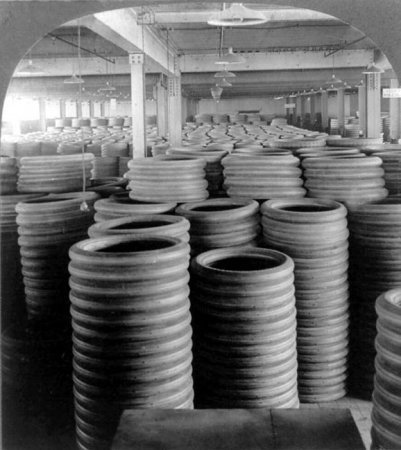Rubber industry
Definition: Enterprises that grow, harvest, process, market, and distribute rubber, as well as those that fashion it into products—primarily automobile tires—and market and distribute those products
Significance: Were it not for the vulcanization of rubber and its subsequent development into tires, the automobile might never have become popular. Although there are other uses for rubber, it is the automobile tire that represents the main product of the industry—an industry dependent on resources originating in underdeveloped regions of the globe.
The name rubber came from the substance used to “rub” out pencil marks, but during the 1850’s, the substance quickly developed into a raw material used in footwear and industry belting products. Most manufacturers of rubber products are, and have always been, in Europe and the United States, but the raw materials for these factories are grown in Southeast Asia and Africa. Rubber is obtained from the sap of a variety of plants, most commonly from what is known as the rubber tree. Approximately four hundred other plants, including common milkweed, contain the latex necessary to make rubber. However, most of these other plants contain such low levels of latex that commercial production using them would not be practical.
The rubber tree originated in South America and was unknown in Europe until Christopher Columbus returned with rubber balls used in Indian games. Raw rubber is not particularly useful, because it eventually rots, so it was not until Charles Goodyear obtained the patent on the vulcanization process in 1844 that rubber became anything more than a toy. The vulcanization process involves adding sulfur to raw rubber and then heating the mixture. L. Candee, a footwear manufacturing company in New Haven, Connecticut, was the first licensee of the Goodyear process.
Initially, all raw rubber came from wild trees in South America, but this source became inadequate by the late 1870’s. Because of high prices and inconsistent quality, rubber manufacturers began raising rubber trees as domestic farm crops. Because rubber trees will grow only within about ten degrees of the equator, in climates where there is more than one hundred inches of rain annually, the obvious sites for plantations were in Southeast Asia and Africa. Virtually all contemporary rubber is grown in Malaysia, Singapore, India, Sri Lanka, and Nigeria.
With the invention of automobiles, tire manufacturing consumed a larger percentage of the rubber crop. The tire factories sprang up in various locations, but a large number were in Ohio (mostly around Akron), Massachusetts, and California. These three states produced nearly all of America’s automobile tires during the 1920’s.
The stockroom of a large automobile tire factory in Akron, Ohio, in 1917. (Library of Congress)
Other components of the rubber industry include manufacturers of synthetic rubber and recyclers of rubber. Synthetic rubber gained importance during World War II, when the United States had its raw material supply from Asia cut off by the war. Ingredients of synthetic rubber include coal, grain, and petroleum. During the late twentieth century, rubber recyclers grew in importance. These companies acquire old, worn-out tires and reprocess them into new rubber, or use them as fuel.
The rubber industry has been at the foundation of the transportation industry for a century. Without rubber to cushion the ride, it is questionable whether automobiles would have ever achieved their present status.
Dale L. Flesher
Further Reading
Korman, Richard. The Goodyear Story: An Inventor’s Obsession and Struggle for a Rubber Monopoly. San Francisco, Calif.: Encounter Books, 2002.
Slack, Charles. Noble Obsession: Charles Goodyear, Thomas Hancock, and the Race to Unlock the Greatest Industrial Secret of the Nineteenth Century. New York: Hyperion, 2002.
Sull, Donald N., Richard S. Tedlow, and Richard S. Rosenbloom. Managerial Commitments and Technological Change in the U.S. Tire Industry. Boston: Harvard Business School, 1997.
See also: agribusiness; U.S. Department of Agriculture; automotive industry; Chemical industries; Trucking industry; World War II.


